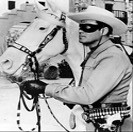If you’re of a certain age, or if you enjoy watching early-era TV shows, you no doubt recognize the title of this article as a frequently asked question at the end of many episodes of The Lone Ranger, a popular TV western that aired from 1949-1957. The show was based on the premise that the Lone Ranger, who disguised his identity with a mask, was the only survivor of a group of massacred Texas Rangers and that he and “his faithful Indian companion Tonto led the fight for law and order in the early West.” Part of the show’s mystique was that the Lone Ranger never removed his mask or revealed his true identity. Thus, when he rode off at the end of each episode “in a cloud of dust and a hearty “Hi-Yo Silver! Away!”, a resident of the town to which the Lone Ranger had brought justice would say, “Who was that masked man?”
 In the days of Covid-19, we’ve grown accustomed to seeing people in masks and wearing them ourselves. You’ve probably seen face covers as elaborate as a gas mask and as simple as a bandana. Unlike the Lone Ranger, the purpose is not to hide your identity but to protect others should you unknowingly be a carrier of the virus.
In the days of Covid-19, we’ve grown accustomed to seeing people in masks and wearing them ourselves. You’ve probably seen face covers as elaborate as a gas mask and as simple as a bandana. Unlike the Lone Ranger, the purpose is not to hide your identity but to protect others should you unknowingly be a carrier of the virus.
But I’m finding it hard to communicate from behind the mask, aren’t you? Conversations are shorter, speech more difficult. The only methods of expressing the emotions of the message are tone of voice (which is often louder than usual) and the eyes. And with masks and social distancing, it seems that folks are even avoiding eye contact, which – as far as I know – isn’t likely to spread the virus.
But you know what’s interesting? With or without the pandemic, people wear masks every day – masks to hide their real identity, to pretend to be something or someone they’re not, to disguise true feelings, to cover fears or ignorance, to hide what they believe to be their flaws or imperfections, to avoid having conversations about hard issues that may cause disagreement, discomfort, or embarrassment. Bottom line: a mask hinders communication and conceals the real person.
The events that have occurred since the death of George Floyd must cause us to examine the masks we wear and to start asking, “Who is that masked man?” “Who is that woman…really?” It’s time – past time – to remove the masks of color and social differences and see the heart, the uniqueness of every individual. And to reveal our own.
This story appeared last week in the Ft Worth Star-Telegram. It’s about two people who willingly took off the masks, had a genuine conversation, and came away with not only a deeper understanding but also a new respect and friendship. The conversation wasn’t planned. It wasn’t the result of a focus group or a task force. It was a chance meeting. A coincidence? I think not. More like a God-incidence. Check it out. It’s a good read. https://www.star-telegram.com/news/business/article243191611.html
So here’s the question…
Are you willing to take off your mask? Are you willing to be open, vulnerable, willing to talk about hard issues? Are you willing to let people know who you are? Who you really are? And are you willing to accept, try to learn about, understand, and yes – even love – others who are masking their true selves? Are you willing to remove your mask and invite others to do the same so that you can know them?
People ride in and out of our lives every day. So, be sure you make the effort to know who they are – what makes them special, what makes them them.
Making the effort to remove the masks will yield tremendous benefits to you personally and for society as a whole.
Like the Lone Ranger, many people never remove their masks. But when the day comes for you to ride out of town in a cloud of dust, make sure the people left behind aren’t asking, “Who was that masked man?” (or woman).
©2020 Julie Alexander

